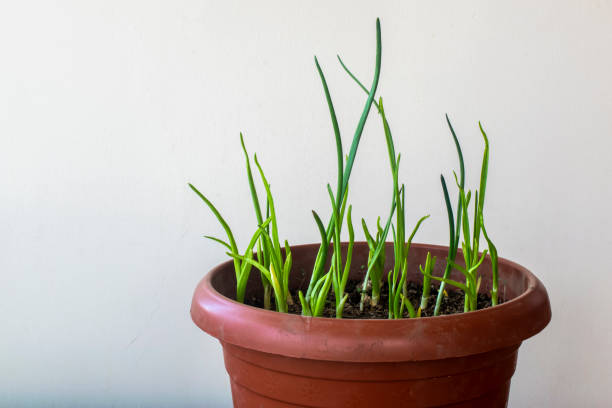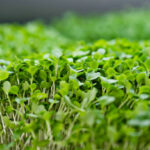
Garlic is a popular herb renowned for its distinct flavor and wide range of health benefits. With our thorough guide, you can easily grow garlic in containers, regardless of the amount of gardening space available to you. Whether you’re an urban dweller with only a small balcony or someone who simply wishes to make the most of their indoor space, you’ll find this guide a helpful resource.
Understanding Garlic and its Varieties
Garlic (Allium sativum) is a hardy member of the Allium family, sharing the same genus as onions, chives, and leeks. While garlic is notably resilient in cooler climates, it can be grown all year round across USDA Hardiness Zones 4-7. If you’re outside these zones, don’t fret; a few extra measures can ensure your garlic thrives.
When choosing the variety of garlic to grow, the choice generally falls between softneck and hardneck types. While both offer similar taste profiles, the growing conditions and specific characteristics might favor one over the other.
Softneck garlic is known for its numerous, albeit smaller, cloves within a single bulb and generally performs better in milder climates. On the other hand, hardneck garlic produces fewer but larger cloves, making it ideal for colder climates. An interesting feature of hardneck garlic is the production of a flower stem, or “scape”, from the center of the bulb. When considering storage, softneck garlic boasts an impressive shelf-life of over a year, while hardneck varieties can be stored for approximately six months.
The Perfect Time to Plant Garlic in a Pot

Whether you opt for hardneck or softneck garlic, planting should ideally take place in the fall as the temperatures begin to cool. Similar to other bulbous plants, garlic cloves start forming roots well before the leaves sprout. By planting in fall, the garlic has the opportunity to establish roots during the colder weather without initiating leaf growth immediately, thereby gaining a head start for spring.
Step-By-Step Guide to Planting Garlic in A Pot
After deciding on the variety of garlic you wish to grow, the following step-by-step guide will assist you in successful planting:
- Choose the Right Container: Given garlic’s need for ample moisture yet shallow root system, opt for planter boxes or shorter containers. Plastic containers are particularly favorable as they retain moisture better than clay counterparts and are lighter, simplifying repositioning if needed.
- Prepare Your Soil: Fill the container halfway with a high-quality potting mix, incorporating a well-balanced organic fertilizer, such as Espoma Garden-tone, into the soil. Add more potting mix until about an inch below the container rim, and blend in some more fertilizer.
- Select the Garlic Cloves: Separate all the cloves from a head of garlic, choosing larger, firm cloves for planting and discarding any that are overly small or soft. While you can remove the excess papery sheath, ensure the main outer coat remains intact.
- Plant the Garlic Cloves: Insert each clove, pointy side up, into the prepared soil, planting at approximately twice the depth of the clove. Maintain a spacing of about three inches between each planted clove.
- Water Your Garlic: Thoroughly water the container until excess water drains from the bottom. It’s normal for the potting mix to settle, possibly exposing some cloves. If this happens, add more soil to cover them.
Caring for Your Potted Garlic
After planting, water your container thoroughly until excess moisture drains out from the bottom. As garlic requires a chilling period for proper development, placing your potted garlic outdoors in an area experiencing temperatures under 40℉ for about two months is ideal. Protect your plants in extremely cold winter areas by covering the pot with straw or fallen leaves. Water regularly to maintain soil moisture, but avoid watering when the potting mix is frozen.
As the garlic starts sprouting leaves, place the container in a location that receives at least 8 hours of sunlight daily and continue to water the plants sufficiently. Fertilize your garlic every other week with a general-purpose or garlic-specific organic fertilizer.
Growing garlic in pots indoors is also feasible, particularly for harvesting edible leaves rather than bulbs. Position the planted cloves in a south-facing window for ample light and hydrate the pot well.
Expert Tips for Nurturing Garlic in Pots
Like other bulbs, garlic requires a chilling period of approximately two months under 40℉ to develop properly. To protect your newly planted garlic in extremely cold winter areas, cover the pot with a thick layer of straw or fallen leaves. You can also keep the pot in an unheated space such as a garage until spring. Water your potted garlic enough to keep it moist throughout the winter, but avoid watering if the soil is frozen.
Once your garlic begins to grow leaves after the chilling period, place the container in a location with full sun exposure (at least 8 hours per day) and provide ample water. In hotter, drier climates, daily watering might be necessary. Bi-weekly, enrich your plants with a general-purpose fertilizer or an organic blend specifically designed for garlic, like Keene Garlic’s mix.
Concluison
In conclusion, with this comprehensive guide, you are well-equipped to successfully grow garlic in containers, irrespective of your outdoor gardening space. Dive into this rewarding experience and enjoy the convenience and satisfaction of harvesting your own garlic.
FAQ
Can You Grow Garlic Indoors?
Indeed, you can grow garlic in containers indoors, albeit primarily for its edible leaves rather than the bulbs, without supplemental lighting. Simply position the planted cloves near a south-facing window as soon as the leaves push through the soil surface, keeping the pot well-watered. Fertilizing indoor garlic isn’t required as the cloves possess sufficient stored nutrients to support the leaves. You can harvest garlic leaves once they’ve grown a few inches, and the cloves may sprout a second flush of leaves for another harvest.






